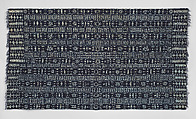Stitch resist indigo wrapper
Not on view
This is an example of the chic garments popular with elite women in French West Africa’s historical capital, Saint-Louis, in the early twentieth century. The composition involves sixteen parallel units bracketed between broad border bands modeled on the aesthetics of strip weaving, but the wrapper is in fact assembled from two similarly sized panels of imported cotton fabric stitched together. The illusion of parallel bands was created through a labor-intensive patterning process known as “stitch-resist.” Handcrafted stitches are used to form intricate patterns (here derived from Hispano-Moresque culture). The embroidered cloth is immersed several times in an indigo bath until the desired color intensity is achieved, and then the stitches are unpicked, revealing white areas underneath. Finally, the garment is washed and pressed to produce a crisp, shiny surface that emphasizes the cloth’s preciousness and the elegance of the wearer.
Due to rights restrictions, this image cannot be enlarged, viewed at full screen, or downloaded.

